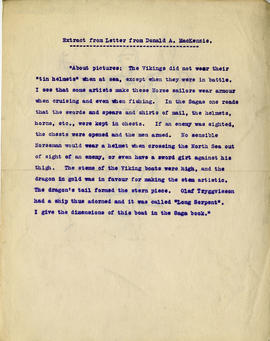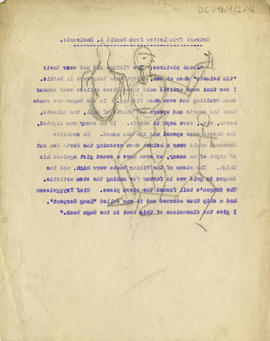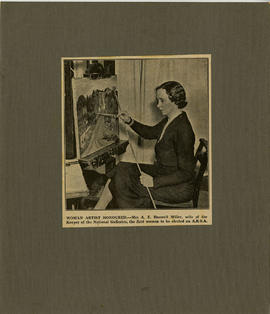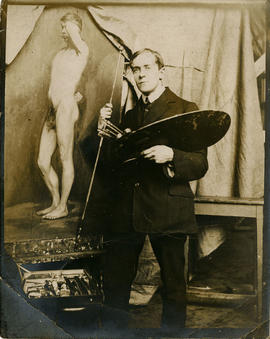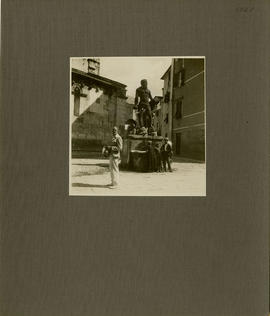Key Information
Reference code
Title
Date(s)
- [1885-1943] (Creation)
Level of description
Collection
Extent
3 Boxes, 174 items
Content and Structure
Scope and content
A variety of loose artworks, cover designs, correspondence, ephemera, photographs, diaries and sketchbooks completed by and belonging to Archibald Haswell Miller and Josephine Haswell Miller (nee Cameron). The collections includes proofs for book covers and pamphlets, personal correspondence relating to his studies and subsequent career, different ephemera relating to Haswell Miller's student days and photographs of artworks and students and staff members of The Glasgow School of Art.
This collection also includes material relating to Georges-Marie Baltus (DC 098/2) , including photographs of his artworks and his Italian and European trips, and Francis H. Newbery (DC 098/3).
Appraisal, destruction and scheduling
Accruals
System of arrangement
These items have been arranged by type across four subfonds: Material related to Archibald Haswell Miller (DC 098/1), Material related to Georges-Marie Baltus (DC 098/2), Material related to Francis H. Newbery (DC 098/3 and Material related to Josephine Haswell Miller (DC 098/4).
The material related to Haswell Miller has been arranged into six individual series: Material featuring designs by Haswell Miller (DC 098/1/1), Correspondence (DC 098/1/2), Ephemera (DC 098/1/3), photographs (DC 098/1/4), diaries (DC 098/1/5) and sketchbooks (DC 098/1/6). DC 098/1/1, DC 098/1/2, DC 098/1/5 and DC 098/1/6 have been arranged chronologically where possible, whereas DC 098/1/3 and DC 098/1/4 have been kept in the same order that they were deposited.
The material related to Georges-Marie Baltus has been arranged into two individual series: Photographs of artworks (DC 098/2/1) and Photographs of trips (DC 098/2/2), respecting the same order in which they were deposited.
This has altered the original arrangement of the items when they were deposited with The Glasgow School of Art Archives and Collections.
General Information
Name of creator
Biographical history
Haswell Miller was a painter and curator, born in Glasgow, where he studied at The Glasgow School of Art under Maurice Greiffenhagen and Jean Delville, 1906-9, then for a year in Munich. He was married to the artist Josephine Miller. Miller taught at The Glasgow School of Art for 20 years from 1910, apart from during World War I, then was keeper and deputy director of the National Galleries of Scotland, 1930-52. He also held positions with the Royal Fine Arts Commission, National Buildings Record and Scottish Council. He also wrote, especially on military uniforms. He sometimes signed his work H M, and exhibited at RSW, of which he was a member, and RSA, also RA and Royal Glasgow Institute of the Fine Arts. Imperial War Museums and Glasgow Museums and Art Galleries hold his work. He lived for many years in Edinburgh but latterly in Gillingham, Dorset. A E Haswell Miller appears on The Glasgow School of Art's First World War Roll of Honour, where he is commemorated as a captain of the Highland Light Infantry. He was decorated with a military cross. If you have any more information, please get in touch.
Name of creator
Biographical history
George Baltus was a Belgian artist and lecturer born in 1874. Baltus married Sivia von Hildebrand, the daughter of the German sculptor Adolf von Hildebrand, in 1904. He began his relationship with the School as an occasional visiting lecturer around 1906. He gave talks to the students on subjects such as composition and the history of art in major cities such as Florence. He was recruited as a permanent member of staff in 1908 and his lecture series developed to include techniques and processes. He released a book during his time at the School called The Technics Of Painting. Baltus returned to Belgium on the outbreak of the First World War where he stayed in active resistance to the German invasion and didn’t return to Glasgow. In 1920, Baltus was appointed professor at the Academy, a position he kept till he left in 1925 for the Acadlmey of Elsene (Ixelles/Brussels). He stayed involved in Leuven affairs as general inspector for art schools in the Belgian Flemish Region. If you have any additional information please get in touch.
Resources used: Nineteenth-Century Art Worldwide: a journal of nineteenth-century visual culture, The Influence of Theosophy on Belgian Artists, Between Symbolism and the Avant-Garde (1890-1910), The Glasgow School of Art Archives and Collections, The Glasgow School of Art Prospectuses, The Flower and the Green Leaf: Glasgow school of Art in the time of Charles Rennie Mackintosh, edited by Ray McKenzie, The Glasgow School of Art: the history, by Hugh Ferguson, The Glasgow School of Art Archives and Collections, Records of The Glasgow School of Art, 15th century-2014. Additional information provided by a private researcher.
Name of creator
Name of creator
Name of creator
Name of creator
Biographical history
Catterns was Secretary and Treasurer at The Glasgow School of Art between 1873-1908.
Name of creator
Name of creator
Biographical history
Maurice Grieffenhagen (15 Dec 1862-26 Dec 1931) was a painter of portraits and idyllic subjects, and a poster designer, decorator and illustrator, born in London, of Baltic German descent. he entered the R.A. Schools 1878; and won the Armitage Medal and other awards. From 1887 he was much engaged in book illustration, particularly for Rider Haggard's novels and for periodicals. He was influenced by Rossetti and the Venetians. He exhibited at the R.A., chiefly portraits, from 1884; A.R.A. 1916, R.A. 1922, and also exhibited at Munich, Dresden, Ghent and elsewhere. He taught at Glasgow School of Art 1906-1929. He decorated the British Pavilions for the Paris Exhibition 1925 and Antwerp 1930, but died in London the following year.
Greiffenhagen was appointed as Professor of the Life Classes (with responsibility for Drawing and Painting, Composition and so on) in 1906 and retired from the School in 1929. Greiffenhagen worked at the School for six months of every year. He kept a house in London and visited GSA when necessary to set work and check the progress of his students, leaving much of the actual teaching in the hands of his assistant professors, David Forrester Wilson and others. Greiffenhagen had to be present for examinations, the end of the year diploma show and at other formal occasions but for the most part he was allowed plenty of time to himself to ensure that his own career as an artist did not suffer. He was elected to the Royal Academy in 1922 at the same time as another GSA staff member Robert Anning Bell, and a luncheon was held for School staff to celebrate the occasion.
Name of creator
Name of creator
Biographical history
Jackson was a both a student and member of GSA staff between 1904 and 1913.
Name of creator
Name of creator
Name of creator
Biographical history
Painter in oil, tempera and watercolour, and etcher. Born in Glasgow, she studied art at The Glasgow School of Art under Robert Anning Bell and Maurice Greiffenhagen. Exhibited RA, RSA, in the provinces and in America. Glasgow Corporation and the RSA bought her work. She was married to the artist Archibald E Haswell Miller and lived in Scotland for some years, later settling in Gillingham, Dorset.
She also taught Etching at The Glasgow School of Art from session 1924/25 to 1931/32.
Name of creator
Biographical history
Helen Muspratt was one of the leading women photographers in Britain in her time. She is best known as the co-founder of the firm Ramsey & Muspratt, photographers to leading Oxbridge subjects. In 1929 she opened a studio in Swanage and it was during these early years that she experimented with innovative techniques including solarisation.
Name of creator
Biographical history
Francis Henry Newbery, known as Fra. Newbery, was the Headmaster and Director of the Glasgow School of Art from 1885 to 1918. During that time the profile of the School was raised from that of a moderately successful institution to one an international reputation.
Newbery was born on 15 May 1855 in Membury, East Devon. He grew up in Dorset and studied as an Art Master in Bridport, before moving to London in 1875 to continue working as an Art Master there. In 1877 he started attending the National Art Training School at South Kensington where he was taught by Edward Poynter and other artists of the time. By 1885 he had taught in most of the School's classes and, at the age of 30, was appointed to the post of Headmaster of Glasgow School of Art.
His success at Glasgow School of Art was led by the acclaim and notoriety surrounding the work of designers and artists such as Charles Rennie Mackintosh, Margaret Macdonald, Frances Macdonald, Herbert McNair, Jessie M. King and others working in the 1890s in Glasgow. It was most highly acclaimed at the Turin Exhibition of Decorative Art, 1902. Much of this success was due to Newbery who selected the work and chose Mackintosh to design the rooms for its display. For this work Newbery was awarded an Italian knighthood.
Newbery oversaw the erection of the new School building at 167 Renfrew Street. He had drawn up the brief, based on his own personal experience and the demanding Department of Science and Art specifications, and he appreciated Mackintosh's design for its practical interpretation. In favouring Mackintosh's plans, he was supported by the Governors of Glasgow School of Art and the official Department of Science and Art advisors.
Under the Scottish Education Department in 1901, Newbery devised his own curriculum which led to the award of a Diploma. The course was divided into four stages, which did not necessarily correspond to years - students were moved through at their own pace, some taking seven or eight years and others only three. Many were not ever awarded the Diploma.
Staff brought in by Newbery to teach at the School included, among others, the Belgian Symbolist painter Jean Delville, the English portraitist, Maurice Greiffenhagen, the French Adolphe Giraldon, the English Decorative artists W.E.F. Britten and Robert Anning Bell and, as Head of Architecture, the French architect Eugene Bourdon. There was also a strong core of Glasgow School of Art trained teachers including Jessie Newbery, Anne Macbeth, Dorothy Carleton Smyth, Olive Carleton Smyth, Allan D. Mainds, James Gray and de Courcy Lewthwaite Dewar.
Newbery inaugurated many schemes at the School including the Glasgow School of Art Club and the Artist Teachers' Exhibition Society, both of which encouraged exhibitions and competition within the School, and allowed present and former staff and students to meet. He invited leading figures in the art and design worlds to lecture at the School including Walter Crane, C.F.A. Voysey, William Morris and Lewis F. Day. He established good contacts with Glasgow University so that the students received lectures in anatomy, art history, philosophy and literature, beyond those available within the School.
Newbery exhibited with the Glasgow Boys, and had close ties to John Lavery, James Guthrie and E.A. Walton. His paintings were exhibited world-wide and he was particularly successful in Italy. From 1890, most of his holidays were spent in Walberswick, Suffolk, often in the company of other Scottish artists, such as Mackintosh and the young W.O. Hutchison.
In 1918 he was granted early retirement on medical grounds, and moved to Corfe Castle, Dorset where he continued to paint, mainly in the field of public art. He died at the age of ninety-one on 18 December 1946. Jessie Newbery died sixteen months later.
Name of creator
Name of creator
Name of creator
Administrative history
The Glasgow School of Art has its origins in the Glasgow Government School of Design, which was established on 6 January 1845. The Glasgow Government School of Design was one of twenty similar institutions established in the United Kingdom's manufacturing centres between 1837 and 1851. Set up as a consequence of the evidence given to the House of Commons Select Committee on Arts and their connection with Manufactures of 1835-1836, the Government Schools hoped to improve the quality of the country's product design through a system of education that provided training in design for industry. Somerset House was the first of such schools to be established, opening in 1837, and others followed throughout the provinces.
In 1853 the Glasgow Government School of Design changed its name to the Glasgow School of Art. Following the receipt of some funding from the Haldane Academy Trust, (a trust set up by James Haldane, a Glasgow engraver, in 1833), The Glasgow School of Art was required to incorporate the name of the trust into its title. Consequently, it became the Glasgow School of Art and Haldane Academy, although by 1891 the "Haldane Academy" was dropped from the title. Glasgow School of Art was incorporated in 1892. In 1901 the Glasgow School of Art was designated a Central Institution for Higher Art Education in Glasgow and the West of Scotland.
Initially the School was located at 12 Ingram Street, Glasgow, but in 1869, it moved to the Corporation Buildings on Sauchiehall Street, Glasgow. In 1897 work started on a new building to house the School of Art on Renfrew Street, Glasgow. The building was designed by Charles Rennie Mackintosh, former pupil of The Glasgow School of Art. The first half of the building was completed in 1899 and the second in 1909.
The Government Schools ran courses in elementary drawing, shading from the flat, shading from casts, chiaroscuro painting, colouring, figure drawing from the flat, figure drawing from the round, painting the figure, geometrical drawing, perspective, modelling and design. All these courses were introduced from the start at the Glasgow School apart from that of design. The course in design was the "summit of the system" where students came up with original designs for actual manufactures or decorative purposes and it was not until 1849, when Charles Heath Wilson became headmaster, that classes in design began to be taught. Also in this year Bruce Bell was engaged to teach mechanical and architectural drawing.
After 1853 the above pattern of courses was extended to 26 stages which formed the national curriculum for art schools. This system was known as the South Kensington system. An Art Masters could be awarded by gaining certificates in the available subjects. There was no restriction on entry and students could take as long as they wished to accumulate their passes before being awarded their Art Masters.
In 1901 the Glasgow School of Art was given the power to award its own diplomas. In the same year Art 91D classes for day school teachers commenced which were later known as the Art 55 classes. From 1901 to 1979 the School of Art awarded its own diplomas and thereafter it awarded degrees of the Council for National Academic Awards. In the 1970s the School of Fine Art and the School of Design were established. With the demise of the Council for National Academic Awards, from 1993 Glasgow University awarded the School's degrees in fine art and design.
In 1885 the Glasgow School of Art taught architecture and building construction conforming to the South Kensington system. Following on from the designation of the School as a Central Institution and the empowerment of the School to award its own diplomas, the School and the Glasgow and West of Scotland Technical College worked together to produce a curriculum for a new course leading to a joint diploma.
In 1903 the joint Glasgow School of Architecture was established within the Glasgow School of Art in conjunction with the Glasgow and West of Scotland Technical College. For the new diploma design classes were to be taught at the School of Art and the construction classes at the Glasgow and West of Scotland Technical College. The first diplomas in architecture were awarded in 1910.
In 1924 the Glasgow School of Art became a university teaching institution when the University of Glasgow set up a BSc in Architecture which was to be taught at the School of Architecture. In 1964 the Royal College of Science and Technology (formerly the Royal Technical College, formerly the Glasgow and West of Scotland Technical College) merged with the Scottish College of Commerce to form the new University of Strathclyde. Following the merger the Glasgow School of Architecture came to an end, the last students transferring to Strathclyde degrees and graduating in 1968.
In 1970 the Mackintosh School of Architecture was established. It is housed within the Glasgow School of Art and forms that school's Department of Architecture. Its degrees are accredited by the University of Glasgow and its Head is the University's Professor of Architecture.
The Glasgow Government School of Design was originally managed, as were the other Government Schools, by the Board of Trade and a Committee of Management representing local subscribers. Then, in 1852, the Government Schools of Design were taken over by the Department of Practical Art. This Department was renamed the Department of Science and Art in 1853 and was located in South Kensington, London. The Committee of Management was replaced in 1892 by the Board of Governors. In 1898, control of the School was transferred again, this time to the Scotch Education Department (renamed the Scottish Education Department in 1918).
The School became academically independent in 1901 when it was free to develop its own curriculum and its own diplomas, subject to the approval of the Scottish Education Department. The chief executive of the School was the Headmaster, renamed Director in 1901, and a Secretary and Treasurer was responsible for all aspects of the administration of the School. As the School grew, other administrative posts were added.
Name of creator
Administrative history
The Glasgow School of Art Club was formed under Fra. Newbery in 1885/1886 to enable former students access to GSA and allow for informal meetings between staff, former and present students. The Club's activities included exhibitions, "at homes", theatrical productions and the Vacation Prize Scheme, which was developed to encourage sketching and painting in the open during the summer months. The Clubhouse was in Blythswood Square.
A later iteration was established by The Glasgow School of Art, Glasgow, Scotland, in 1969. The Club was affiliated to the Students Union and was therefore open to present students and also current staff. The society's constitution claims that it object was "the provision for for the members thereof of recreational, social and educational facilities." The Club provided a snack bar and licensed bar as well as meeting rooms.
Name of creator
Name of creator
Name of creator
Archival history
Custodial history
Collection donated in 2010, accession reference number Acc 180.
Additional material (sketchbooks and diaries) donated in December 2023.
Physical Description and Conditions of Use
Conditions governing access
Glasgow School of Art Archives and Collections are open for research by appointment. For further details, please refer to our Access Policy @ https://gsaarchives.net/policies
Conditions governing reproduction
Application for permission to reproduce should be submitted to The Archives and Collections at The Glasgow School of Art.
Reproduction subject to usual conditions: educational use and condition of material.
For further details, please refer to our Reprographic Service Guide @ https://gsaarchives.net/policies
Language of material
- English
- French
- German
- Spanish
Script of material
Language and script notes
Physical Description
Finding aids
Related Material
Existence and location of originals
Existence and location of copies
Related materials
Notes area
Alternative identifier(s)
Keywords/Tags
Place access points
People and Organisations
- Blackie and Son (Subject)
- Miller, Josephine Haswell (Subject)
- Royal Glasgow Institute of Fine Arts (Subject)
- The Glasgow School of Art (Subject)
- University of Glasgow (Subject)
- Miller, Archibald E Haswell (Subject)
- Greiffenhagen, Maurice (Subject)
- Baltus, Georges-Marie (Subject)
- Newbery, Francis Henry (Subject)
- Crombie, A G (Subject)
- Assafrey, Alma Fedora Maude (Subject)
- Musgrove, Alex J (Subject)
- Eadie, Robert (Subject)
- Mainds, Allan Douglass (Subject)
- Revel, John D (Subject)
- Mackie, J C Campbell (Subject)
- Melvin, Grace (Subject)
- McGibbon, Alexander (Subject)
- Davidson, Peter Wylie (Subject)
- Dewar, De Courcy Lewthwaite (Subject)
- Academy of Fine Arts of Munich (Subject)
Genre access points
Status
Level of detail
Processing information
- Initial description created by Carrie Skinner, Archives and Colletions Documentation Assistant in 2017, updated by Susannah Waters, Archives and Collections Manager 01/03/2018.
- Catalogue exported from Archon and imported into AtoM during system migration, 2018-2019.
- Catalogued by Javier Garcia, Intern, Aug 2023, and Ellie Smith, work placement student, Jul 2024.
Language(s)
Script(s)
Sources
Archivist's note
© Copyright 2018 GSA Archives. All rights reserved.





